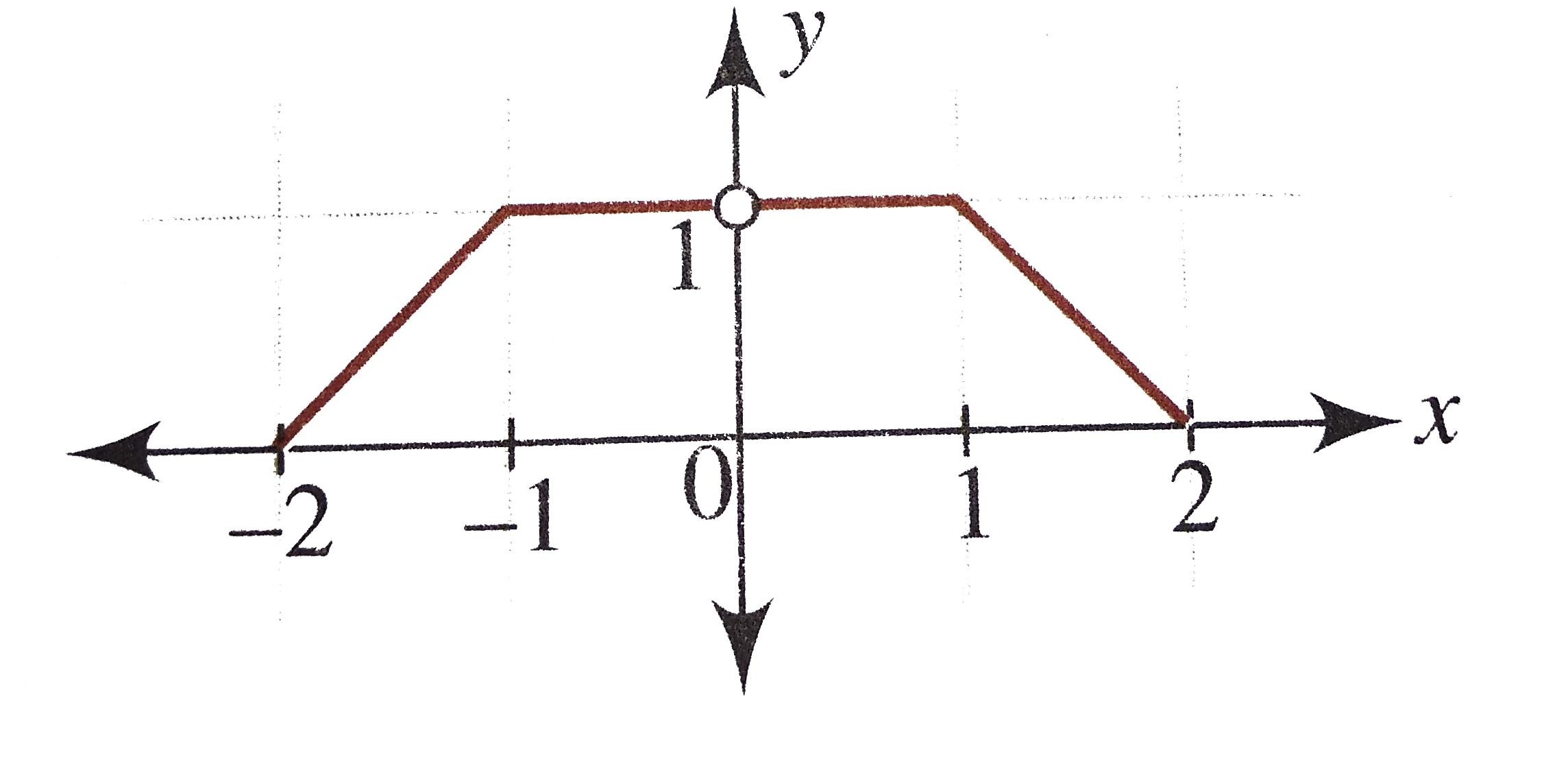Let a function f(x) be defined in [−2,2] as
f(x)=⎧⎪⎨⎪⎩{x},−2≤x<−1|sgn x|,−1≤x≤1{−x},1<x≤2 where {x} and sgn x denote fractional part and signum functions, respectively. Then find the area bounded by the graph of f(x) an the x-axis. Solution in Tamil
2 sq. units
3 sq. units
4 sq. units
5 sq. units
f(x)=⎧⎪⎨⎪⎩{x},−2≤x<−1|sgn x|,−1≤x≤1{−x},1<x≤2
=⎧⎪
⎪
⎪
⎪
⎪
⎪
⎪⎨⎪
⎪
⎪
⎪
⎪
⎪
⎪⎩x+2,−2≤x<−11,−1≤x<0,0,x=01,0<x≤1−x+2,1<x≤2
The graph fo the function is as shown in the following figure.
Area =2+42×1=3 sq. units

Topper's Solved these Questions
- GRAPHS OF ELEMENTARY FUNCTIONS BOOK - CENGAGECHAPTER - GRAPHS OF ELEMENTARY FUNCTIONS EXERCISE - Exercise
34 Videos
- GRAPHS OF POLYNOMIAL AND RATIONAL FUNCTIONSBOOK - CENGAGECHAPTER - GRAPHS OF POLYNOMIAL AND RATIONAL FUNCTIONSEXERCISE - Exercises
4 Videos
- GRAPHS OF TRIGONOMETRIC FUNCTIONSBOOK - CENGAGECHAPTER - GRAPHS OF TRIGONOMETRIC FUNCTIONSEXERCISE - Exercise
22 Videos
Similar Questions
Draw the graph of y=1(1/x).
View SolutionSketch the graph of an example of a rational function f that satisfies all the given conditions.
(i) f(0)=0,f(1),limx→∞f(x)=0,f is odd
(ii) limx→0+f(x)=∞,limx→0−f(x)=−∞,limx→∞f(x)=1,limx→−∞f(x)=1
(iii) limx→−2f(x)=∞,limx→−∞f(x)=3,limx→∞f(x)=3,f(0)=0
View SolutionDraw the graph of y= cosec 2x−cot2x. Is f(x) periodic ? If yes, what is its fundamental period ?
View SolutionIf F(x)=sinπ[x]{x} then F(x) is (where {.} denotes fractional part function and [.] denotes greatest integer function and sgn(x) is a signum function)
View SolutionLet a function f(x) be defined in [−2,2] as
f(x)=⎧⎪⎨⎪⎩{x},−2≤x<−1|sgn x|,−1≤x≤1{−x},1<x≤2 where {x} and sgn x denote fractional part and signum functions, respectively. Then find the area bounded by the graph of f(x) an the x-axis.
View SolutionSolve the following equations (where [⋅] denotes greatest integer function and {⋅} represent fractional part function and sgn represents signum function) (i)[x]+|x−2|≤0 and x∈[−1,3] (ii)[2x]−2x=[x+1]
(iii)[x2]+2[x]=3x, 0≤x≤2
View SolutionLet function f(x) is defined in [−2,2] as f(x)=⎧⎪⎨⎪⎩{x},−2≤x≤−1|sgnx|,−1≤x≤1{−x},1<x≤2 where {x} and sgn x denotes fractional part and signum functions, respectively. Then the area bounded by the graph of f(x) and x-axis is
View SolutionIf f(x)=sgn(cos2x−2sinx+3), where sgn () is the signum function, then f(x)
View SolutionConsider a function defined in [−2,2]
f(x)=⎧⎪⎨⎪⎩{x}−2l≤x<−1|sgnx|−1≤x≤1{−x}1<x≤2, where {.} denotes the fractional part function.
The total number of points of discontinuity of f(x) for x∈[−2,2] is:
View SolutionConsider a function defined in [−2,2]
f(x)=⎧⎪⎨⎪⎩{x}−2≤x<−1|sgnx|−1≤x≤1{−x}1<x≤2, where {.} denotes the fractional part function.
The number of points for x∈[−2,2] where f(x) is non-differentiable is:
View SolutionIf the function f is defined by f(x)=⎧⎪⎨⎪⎩x+2,x>12,−1≤x≤1x−1,−3g<x<−1 then find the values of (ii) f(0)
View SolutionFor the function f(x)=log[x−1]sgn(x) where sgn(x) is the signum function and [x] is GIF, domain of f is.
View SolutionIf f(x)=ln(1+x)−tan−1x1+x, (for x>0) then sgnf(x) is ( sgn represents signum function)
View SolutionThe range of f(x)=3−|x|−3x+sgn(e−x)+2 (where sgn x denotes signum function of x )
View SolutionLet sgn (x) denote the signum function of x. Let A={x∣x≠12nπ,n∈Z} Define f:A→R by f(x)=sgn(cosx)+sgn(sinx)+sgn(tanx)+sgn(cotx) Then range of f is
View SolutionLet f(x)=exsgn(x+[x]) , where sgn is the signum function and [x] is the greatest integer function . Then
View Solution
